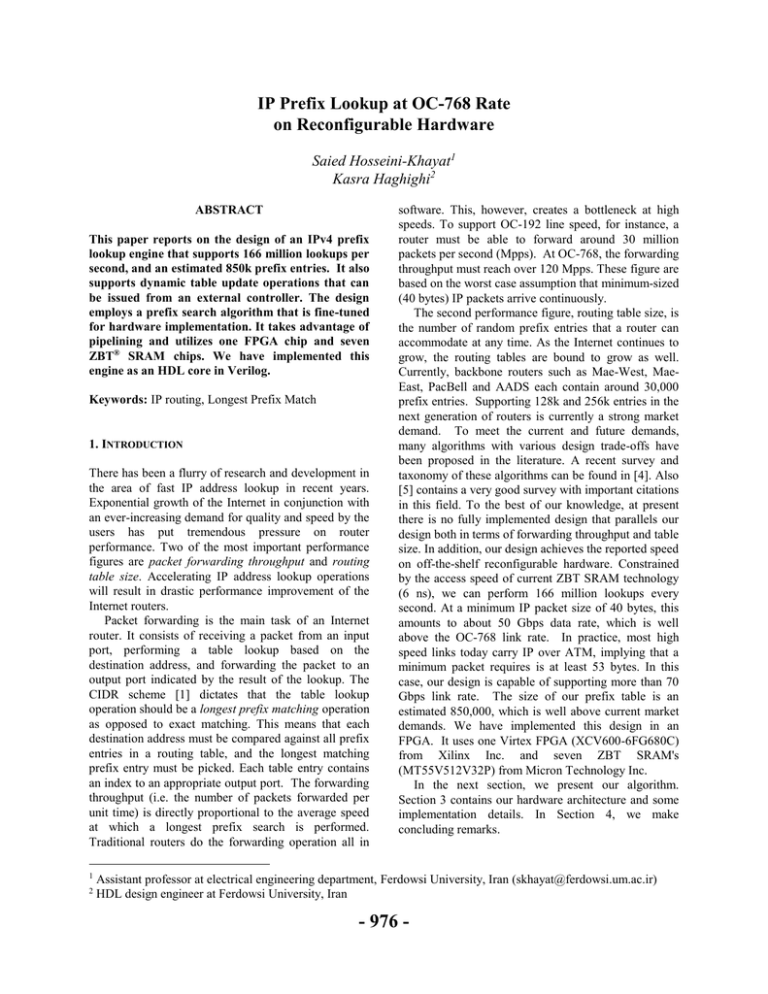IP Prefix Lookup at OC-768 Rate on Reconfigurable Hardware Saied Hosseini-Khayat
advertisement

IP Prefix Lookup at OC-768 Rate on Reconfigurable Hardware Saied Hosseini-Khayat1 Kasra Haghighi2 ABSTRACT This paper reports on the design of an IPv4 prefix lookup engine that supports 166 million lookups per second, and an estimated 850k prefix entries. It also supports dynamic table update operations that can be issued from an external controller. The design employs a prefix search algorithm that is fine-tuned for hardware implementation. It takes advantage of pipelining and utilizes one FPGA chip and seven ZBT® SRAM chips. We have implemented this engine as an HDL core in Verilog. Keywords: IP routing, Longest Prefix Match 1. INTRODUCTION There has been a flurry of research and development in the area of fast IP address lookup in recent years. Exponential growth of the Internet in conjunction with an ever-increasing demand for quality and speed by the users has put tremendous pressure on router performance. Two of the most important performance figures are packet forwarding throughput and routing table size. Accelerating IP address lookup operations will result in drastic performance improvement of the Internet routers. Packet forwarding is the main task of an Internet router. It consists of receiving a packet from an input port, performing a table lookup based on the destination address, and forwarding the packet to an output port indicated by the result of the lookup. The CIDR scheme [1] dictates that the table lookup operation should be a longest prefix matching operation as opposed to exact matching. This means that each destination address must be compared against all prefix entries in a routing table, and the longest matching prefix entry must be picked. Each table entry contains an index to an appropriate output port. The forwarding throughput (i.e. the number of packets forwarded per unit time) is directly proportional to the average speed at which a longest prefix search is performed. Traditional routers do the forwarding operation all in 1 2 software. This, however, creates a bottleneck at high speeds. To support OC-192 line speed, for instance, a router must be able to forward around 30 million packets per second (Mpps). At OC-768, the forwarding throughput must reach over 120 Mpps. These figure are based on the worst case assumption that minimum-sized (40 bytes) IP packets arrive continuously. The second performance figure, routing table size, is the number of random prefix entries that a router can accommodate at any time. As the Internet continues to grow, the routing tables are bound to grow as well. Currently, backbone routers such as Mae-West, MaeEast, PacBell and AADS each contain around 30,000 prefix entries. Supporting 128k and 256k entries in the next generation of routers is currently a strong market demand. To meet the current and future demands, many algorithms with various design trade-offs have been proposed in the literature. A recent survey and taxonomy of these algorithms can be found in [4]. Also [5] contains a very good survey with important citations in this field. To the best of our knowledge, at present there is no fully implemented design that parallels our design both in terms of forwarding throughput and table size. In addition, our design achieves the reported speed on off-the-shelf reconfigurable hardware. Constrained by the access speed of current ZBT SRAM technology (6 ns), we can perform 166 million lookups every second. At a minimum IP packet size of 40 bytes, this amounts to about 50 Gbps data rate, which is well above the OC-768 link rate. In practice, most high speed links today carry IP over ATM, implying that a minimum packet requires is at least 53 bytes. In this case, our design is capable of supporting more than 70 Gbps link rate. The size of our prefix table is an estimated 850,000, which is well above current market demands. We have implemented this design in an FPGA. It uses one Virtex FPGA (XCV600-6FG680C) from Xilinx Inc. and seven ZBT SRAM's (MT55V512V32P) from Micron Technology Inc. In the next section, we present our algorithm. Section 3 contains our hardware architecture and some implementation details. In Section 4, we make concluding remarks. Assistant professor at electrical engineering department, Ferdowsi University, Iran (skhayat@ferdowsi.um.ac.ir) HDL design engineer at Ferdowsi University, Iran - 976 - 2. THE ALGORITHM We started out from the most straightforward way to represent a collection of prefixes, a trie, and came up with a scheme which performs partly a trie walk and partly direct indexing. A trie is a binary tree with nodes that are colored white or gray, like the example shown in Figure 1. All gray nodes represent a given set of prefixes (e.g. prefixes a, b, .., i). All branches that lead to no prefixes are pruned. Associated with each prefix, there is an index which must be found as the result of prefix matching operation. In IPv4 address lookup, we are given a 32-bit address that must be compared against all prefixes in a list, and the prefix that matches the address in the most number of most significant bits must be found. This can be thought of as a “walk” on the trie which represents a given prefix list. The walk is guided by the bits in an IP address, starting from the most significant address bit. a: 1* b: 100* c: 1100* d: 1101* e: 1110* f: 1111* g: 0* h: 010* i: 01111* 1 0 g a 1 0 0 1 0 0 1 produce one such result at every clock cycle. This amounts to a throughput of 166 million lookups per second (assuming current ZBT access time of 6 ns). This solution is fast and easy and can support 32 times as many prefixes as the previous design. But it is extravagant in using RAM chips. Our solution uses only seven RAM chips to produce the same speed. Our scheme is as follows: Instead of 32 RAM accesses, one for each address bit, we perform a total of 7 accesses. The first access uses the most significant 19 bits of the IP address. Then we perform 5 more accesses, each one consuming the next 5 bits of the address consecutively. At the end, we consume the last (i.e., least significant) 8 bits of the address to perform the final memory read. The whole operation thus consumes an entire IP address and returns a final result, the index (showing the output port). The above scheme is carefully designed to suit the dimensions of one of the largest SRAM chips available today. Each of the said accesses is made to a different RAM chip, thus we can take advantage of pipelining. Our design uses seven identical ZBT SRAM chips (Micron Technology part MT55V512V32P), each having 16 Mbits capacity. All of the chips are configured as 512k of 32-bit words. Each and every word of memory represents one node. Each node is a data structure as depicted in Figure 2. 1 b h 0 1 c 1 d 1 0 e 1 2 18 11 bits P LR ADDR INDX f Figure 2. Structure of a node word (32 bits) 1 i Figure 1. An example binary trie Every trie walk starts from the root node and continues until a leaf node is reached. The index of the last gray node seen is the result to be returned. For a detailed presentation of this algorithm and its variants refer to [3]. A trie walk can be implemented entirely in hardware using RAM. The most straightforward implementation would use one RAM chip. Each memory word (say 32 bits) would represent one trie node. In the case of IPv4, at most 32 memory reads (corresponding to 32 IP address bits) would yield a result. This solution has two limitations: (1) low throughput, (2) few number of prefixes supported. A better design would use a pipeline of 32 RAM chips, with each chip containing one level of the trie. Then it would perform one memory read per address bit in a pipelined fashion. This would take 32 clock cycles to get the result for each IP address, and it would In Figure 2, each field has the following meaning: P (1 bit): If this bit is ‘1’, it means this node is a valid prefix. Otherwise, the node does not represent a vaild prefix. LR (2 bits): If LR= ‘00’ then this node has no child. If LR= ‘01’, then this node has only a right child. If LR= ‘10’, then this node has only a left child. If LR= ‘11’, then this node has both a right child and a left child. ADDR (18 bits): This field has the most significant 18 address bits of the children of this node, if a child exists. The least significant address bit of a child node will come from the IP address being processed. INDX (11 bits): This field contains an index if this node is a valid node. In the first lookup stage, the most significant 19 bits of an IP address is used as an address to fetch a ‘node’ from the first SRAM chip. Four cases are possible: - 977 - 1. 2. 3. 4. If the LR field of this node is ‘00’, then its INDX field is the final result, and the lookup process ends here. (In this case, the longest prefix length is less than or equal to 8. The nodes in the first chip implement what is called ‘partial prefix expansion’ [3].) If LR=’01’ then this node has a right child. In this case, if the next bit of the IP address (i.e., 20th bit from the left) is ‘1’, then the ADDR field in the node is used as the most significant 18 bits of an address, and the 19th bit (the least significant bit) is set to ‘1’. This address is then used to fetch the next trie node from the second SRAM chip. If, on the other hand, the next bit of the IP address (i.e., 20th bit from the left) is ‘0’, then the INDX field of the current is the final result, and the lookup process ends at this point. If LR=’10’ then this node has a left child. In this case, if the next bit of the IP address (i.e., 20 th bit from the left) is ‘0’, then the ADDR field in the node is used as the most significant 18 bits of an address, and the 19th bit (the least significant bit) is set to ‘0’. This address is then used to fetch the next trie node from the second SRAM chip. If, on the other hand, the next bit of the IP address (i.e., 20th bit from the left) is ‘1’, then the INDX field of the current is the final result, and the lookup process ends at this point. If LR=’11’ then this node has both a left child and a right child. Now one of the following cases happens: a. The next bit of the IP address is ‘0’, then the ADDR field in the node is used as the most significant 18 bits of an address, and the 19th bit (the least significant bit) is set to ‘0’. b. The next bit of the IP address is ‘1’, then the ADDR field in the node is used as the most significant 18 bits of an address, and the 19th bit (the least significant bit) is set to ‘1’. the trie but accoding to the prefix expansion scheme. To access this SRAM, the last (least significant) eight bits of the IP address is used as the least significant address bits. The remaining 11 bits come from the ADDR field in the previous (sixth) SRAM. The statistics show that there are not many prefixes longer then 8 bits [2]. Therefore although we cannot accommodate the last levels of a trie (which is also the densest part if it is a full trie), we can expect to have room for many prefixes. The scheme in [2] also has the same limitation. Because the memory is limited and we cannot possibly have room for a full trie(a full trie would require 233 words), at times we may run into a lack of space when adding new nodes. In practice, an actual trie is very far from being a full trie and we accept the fact that we cannot accommodate an arbitrary number of prefixes in the memory. This fact applies to other implementations as well. When dynamically updating any of the SRAMs in order to add or delete prefixes, the lookup process must be disabled until the update (SRAM write transactions) are complete. Otherwise the node data in SRAMs may be in an inconsistent state. Inhibiting prefix lookup when update process is ongoing does not pose a performance issue because update operations happen very infrequently compared to lookup operations. We made an estimation of the number of prefixes that our design can accommodate by taking actual routing tables from [3], making the corresponding trie (in software) and then computing the ratio of prefix nodes (nodes with P=’1’) and non-prefix nodes (nodes with (P=’0’) at each trie level. Given that we know the total number of nodes at each trie level (the number of words in each SRAM chip), then we could make a rough estimate of the total number prefixes that can be put into our memories. The number was well above 800k. 3. THE ARCHITECTURE The above logic lends itself very well to fast implementation. Thus a new node address is made and used to read another node from the second SRAM chip. The same procedure is repeated for the next nodes until a node with LR=‘00’ is reached. Every time a node with P=’1’ is reached, the INDX field of that node is saved in a register. The INDX value left in the register is the final result that is sent to the output. The node data in all SRAM chips are all pre-computed. The first SRAM contains the top nineteen levels of the trie. The next five SRAMs each contain one level of the trie. If the IP address which is longer than 24 bits, the search will continue into the last (seventh) SRAM. The data in this SRAM corresponds to the next and last 8 levels of In this section, first we introduce the interface description of our engine. Then, we describe the engine’s different modules. At last, the design tools and implementation results are described. 3.1 Interface The engine has the following interfaces: a. ZBT SRAM interface: Separate data, address and read/write control pins to each of the seven ZBT SRAMs. Other SRAMs pins does not have to come from the engine; this saves FPGA pins. b. Update interface: This interface provides a connection to an external controller for update - 978 - c. d. procedure. The engine supports dynamic update (as opposed to static one-time load at boot time). This interface receives update messages from an external processor and sends to update unit. IP address and INDX interface: Through this interface, 32-bit IP address is fed to the engine each time a signal called IP_ADDRESS_READY is asserted. When a lookup is completed, an 11-bit INDX data is output. Another output signal announces that INDX is ready at output. General interface: Reset, clock input, ZBT clock signal, clock feedback (for internal clock DLL). Table 1 gives a detailed description of interface signals. Table 1. Engine interface signals Signal Name ZBT data ZBT address ZBT R/W ZBT clock Update_data Update_address ZBT_number Update_ready Update_Strobe IP_address IP_address_ready INDX_out INDX_ready Clock Clock_feedback Reset Total Direction Inout Output Output Output Input Input Input Output Input Input Input Output Output Input Input Input No. of bits 32x7 19x7 1x7 1 32 19 3 1 1 32 1 10 1 1 1 1 468 d. e. ZBT lookup blocks: These blocks perform triebased node lookups explained before. Clock management unit: This unit provides deskewed clocks internal blocks and for external ZBT SRAM chips. 3.3 Design Tools and Implementation Results The design was coded in Verilog Hardware Description Language. Behavioral simulation and post-synthesis verifications was performed using Model Technology’s ModelSim (version 5.4e). Xilinx Foundation ISE (vesion 3.3.08i) was used for implementation. FPGA Express (version 3.5.0.6013) from Synopsys was used for synthesis. The implementation report gives the total slice count equal to 1527, equivalent gate count equal to 65596 and a flip flop count of 2780. A total of 468 user pins of the FPGA chip (Virtex XCV6006FG680C) was used. The target frequency for synthesis and implementation was set to 166 MHz. We obtained 233 MHz clock rate at pre-route implementation phase. Finally, the total chip count of this design including ZBT SRAMs is eight. 4. CONCLUSION We have made contribution to the field of IP routing by showing that current SRAM technology allows very high-speed (above OC-768 rate) longest prefix search using not-too-complicated algorithms on off-the-shelf reconfigurable chips. Our claim is supported by actual implementation on the industry-standard FPGA and SRAM chips from Xilinx Inc. and Micron Technology Inc. REFERENCES 3.2 Architecture The ZBT-based IP prefix lookup engine (Figure 3) consists of the following architectural blocks: a. IP address pipeline: The IP address enters a register pipeline that provides the necessary IP address bits to ZBT lookup blocks at appropriate times. IP address can enter this pipeline at every clock cycle. b. Update control block: This block starts an update operation (a SRAM write) when a strobe signal from the external controller is assterted. It monitors the IP address ready signal looking for a time gap between incoming IP addresses. When it finds one, it schedules a write operation to the appropriate ZBT SRAM. After updating, it asserts a ready signal to lookup block to resume operation. c. Main Control block: This is the core of all ZBT lookup blocks. It controls the required reads and writes to ZBT SRAMs. [1] V. Fuller, V. Li, J. Yu, K.Varadhan, “Classles InterDomain Routing (CIDR): an address assignment and aggregation strategy.” Internet RFC 1519, 1993. [2] P. Gupta, S. Lin, N. McKeown. “Routing Lookups in Hardware at Memory Access Speeds.” IEEE Infocom'98, April 1998. [3] IPMA Statitics Web Site. http://www.merit.com/ipma [4] M. A. Ruiz-Sanchez, E. W. Biersack, W. Dabbous. “Survey and Taxonomy of IP Address Lookup Algorithms.” The IEEE Network Magazine, March/April 2001. [5] M. Waldevogel, G. Varghese, J. S. Turner, B. Plattner. “Scalable High-Speed Prefix Matching.” ACM Transaction on Computer Systems, 2001. - 979 - IP Address Ready IP Address Update Data & Address Update Strobe Update Ready Clock Update Control Block Main Control Block Clock Manage ment Virtex FPGA Chip IP Address Pipeline ZBT Lookup7 Block 1bit ZBT Lookup Block ZBT SRAM 7 1bit ZBT Lookup Block ZBT SRAM 6 1bit ZBT Lookup Block ZBT SRAM 5 1bit ZBT Lookup Block ZBT SRAM 4 1bit ZBT Lookup Block ZBT SRAM 3 19 bits ZBT Lookup Block ZBT SRAM 2 8 bits Reset ZBT SRAM 1 Figure 3. IP Lookup Engine Architecture INDX_Ready INDX_OUT - 980 -



